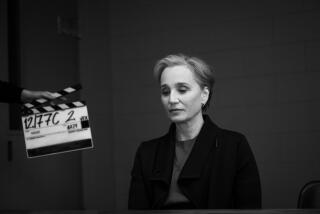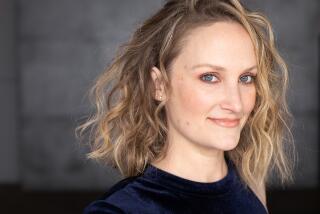A pregnant woman is gaslit by in-laws in âKindred.â Hereâs where the idea came from
With the gaslighting thriller âKindred,â writer-director Joe Marcantonio paints a portrait of an expectant mother manipulated to the brink of insanity by her late boyfriendâs family.
Although the film centers on the experiences of a pregnant woman, the writing was heavily informed by the experiences of the two male writers.
While working on the first draft of the script with co-writer Jason McColgan, Marcantonio and his wife were preparing for the arrival of their second child. Although they had planned for a home birth, the baby was more than two weeks late. âThe doctors kept trying to force us to go into the hospital to have a C-section,â he recalled. âWe woke up the day before they were going to force us to come in and my wife went into labor right then and there. We basically delivered my daughter ourselves on the bedroom floor. So that was quite a traumatic thing to go through.â
At the same time, McColgan was having the opposite problem. âHis wife was having twins and they were born super premature,â said Marcantonio. âLike if itâd been a couple of weeks earlier, they wouldnât have made it. They were in the hospital for two months in incubators. So the weird position that we were both in really fed into the themes of what was going on in the film.â
âKindredâ stars up and comer Tamara Lawrance as Charlotte, a young woman with no worldly attachments who becomes unexpectedly pregnant and forced to carry the baby to term. She has no designs on being a mother, but after the tragic death of her boyfriend, she is taken in by his overbearing mother Margaret (played by Fiona Shaw) and stepbrother Thomas (Jack Lowden) whoâve completely inserted themselves into her pregnancy.
The film draws obvious comparison to the genre classic âRosemaryâs Baby,â and while Marcantonio admits it was on his mind during the writing process, he says âKindredâ was influenced more by films like Alfred Hitchcockâs âNotoriousâ and Sean Durkinâs âMartha Marcy May Marlene.â âI watched [âRosemaryâs Babyâ] and discussed it, but it never came up as a reference point for the look and feel of the film. But in the script writing it was definitely something we were conscious of.
âThereâs a lot of my personal experience of having kids in the film,â said Marcantonio of his feature debut. âI found having one kid quite a tricky thing to transition into. And I found having two kids [even harder]. I know people say that dads can get postnatal depression. I donât know if Iâd label it that way, but I definitely found it a very difficult thing to adjust to mentally for a whole ton of reasons. I think that played a massive part in the writing of the film.â
âYou donât hear about it a lot but a lot of people really struggle with having children,â said Lawrance. âSome people always regret it, actually. I found some forums online of parents talking about how much they regret their kids, even to this day.â
âWhen we first found out we were having a kid, itâs not that I wasnât excited about it,â Marcantonio clarified. âBut, and itâs quite hard to admit, thereâs a little part of oneâs brain that does go, âHoly sâ, my life is going to change beyond all recognition.â In movies, people find out theyâre pregnant and itâs like this big celebratory moment. Thereâs always that overwhelming rush of love that the parent immediately feels when seeing the baby for the first time. But that really wasnât the case for me. The first time I saw my son, I was just like, âWhat the fâ am I supposed to do now?ââ
The premise of the story first came to Marcantonio 10 years ago, originally imagined from Margaretâs perspective. âIt was an idea I almost immediately rejected because at the time, I could only really see it from the familyâs point of view,â he said. âAnd it felt like it was going to be a grisly horror number and Iâm not really into that kind of thing. So I just kind of left it in my ideas folder.â
Years later, while attending a prenatal baby class in preparation for his first child, he met producer Dominic Norris, whom he went on to collaborate with on the 2017 short âRed Light.â After that experience, the pair set their sights on making a feature.
âAll of a sudden, this idea that I had kept for 10 years suddenly jumped out at me because I was now a parent â my perception of what the story could be was completely different,â said Marcantonio. âNow all of a sudden I saw it as an opportunity to tell it from the girlâs point of view and to make it more of a suspenseful, gaslighting film rather than a kind of schlocky, lock-a-girl-up movie.
âFor some reason Iâm really interested in truth and honesty and the fact that you can never really understand what anyone else is thinking. I just find the fact that youâre never truly in someone elseâs brain a really interesting thing.â
The idea to approach Shaw for the role of Margaret was floated by casting director Alice Searby. âI didnât think sheâd do it,â Marcantonio said. âBut we asked her and she wanted to meet for tea. Sheâs so nice and super smart. Sheâs about as honest and talented an actor as anyone Iâve ever come across in my life. She was kind of into it after the meeting and then she invited me around to her house for tea a couple weeks later. We had a really nice couple of hours chatting it through and then she was in.â
âIf anybody asks you to do a film, itâs always a compliment,â said Shaw. âAnd Joe had sort of concocted this mixture of horror and suspense. We talked about the script a lot. He was very interested in anything any of the actors had to say about character. But I believe that character is situational. The situation is accurate, the character emerges. So I was very taken with it.â
The director credits Lowden, who also serves as a producer on the film, for putting Lawrance onto his radar. âJack had just gotten back from the Dominican Republic where he was shooting with Tamara in a show called âThe Long Songâ for BBC One,â said Marcantonio. âAnd he was like, âYouâve got to check out Tamara, I just shot this thing with her, sheâs amazing.â She was the last person we saw and within about three minutes, me and Alice turned to each other and were just like âRight, well, thatâs done.ââ
Although Lawranceâs identity as a Black woman brings an added shade of symbolism to the story, Marcantonio insists any message about race is unintentional. âWe purposely never mentioned race or any kind of ethnicity at all in the writing,â he said. âWe just wanted to cast someone who was good for the part. And really genuinely not for any kind of âwokeâ reason, it was just that I thought it [made the story] more interesting.â
âI was always super honest with Tamara that I cast her because she was the best actress we saw, not that she was the best Black actress we saw,â he added. âAnd I know as a white middle-class dude, it feels kind of like an eggshell thing to talk about. But I am aware that she is a wonderful, talented, Black woman who I admire very much. And I didnât want to deny her of her Blackness. I wanted to give her the opportunity for that to be part of the story she was telling. Itâs not my position to say that it doesnât matter because itâs part of who she is as a person.â
âI think itâs really interesting the undertones and overtones of being Black in that environment,â said Lawrance. âBut I think whatâs interesting about Charlotte is that sheâs chosen to be there â sheâs chosen to run away from community and familiarity. Thereâs obviously an argument [to be made] for the reasons sheâs treated a certain way and not believed. Thereâs definitely resonances between being a Black person in a white institution and recognizing that something is unfair or unjust about the situation, even if you canât quite put your finger on it. Thereâs a parallel between that and the experience of many Black people around the world.â
Marcantonio admits he did make one script change after casting Lawrance. âWe did have her shackled by the ankle in the first draft and that changed for two reasons,â he said. âOne, it feels like there are racial motifs about chains and shackling and that makes it feel like weâre trying to make a statement about something that weâre not. But equally, it just felt one step too cruel for Thomas and Margaret.â
Releasing the film in the midst of the COVID-19 pandemic has left Marcantonio in the dark about the next steps for his career.
âThe way cinema has been going, I was never really convinced that weâd end up with a big massive cinematic distribution anyway,â he said. âWhat Iâve found most frustrating is the lack of festivals and networking. Because Iâm a first-time filmmaker and I donât have an agent [in the U.K.], I donât know whatâs going on with my career in a wider sense. And usually that gets fixed when you have a festival run. You go and meet people and schmooze and that stuff happens. But now Iâve got to try and work out what to do with my career.â
On the other hand, Lawrance is hopeful that the shared experience of quarantining and social distancing will allow the film to resonate deeper with audiences. âI think itâs cool that despite the odds, film is finding initiative,â she said. âItâll be an interesting experience for people to see something like this in the comfort of their own homes. Especially people whoâve spent a long time being isolated this year. I think everybody will have a particular empathy with being stuck.â
More to Read
Only good movies
Get the Indie Focus newsletter, Mark Olsen's weekly guide to the world of cinema.
You may occasionally receive promotional content from the Los Angeles Times.











